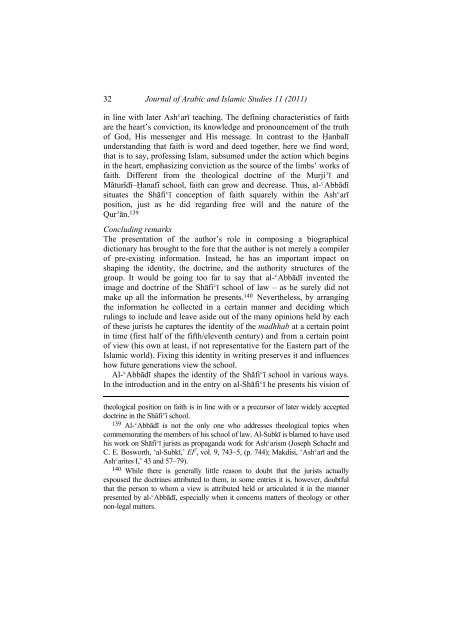JOURNAL OF ARABIC AND ISLAMIC STUDIES
JOURNAL OF ARABIC AND ISLAMIC STUDIES
JOURNAL OF ARABIC AND ISLAMIC STUDIES
Create successful ePaper yourself
Turn your PDF publications into a flip-book with our unique Google optimized e-Paper software.
32<br />
Journal of Arabic and Islamic Studies 11 (2011)<br />
in line with later Ashʿarī teaching. The defining characteristics of faith<br />
are the heart’s conviction, its knowledge and pronouncement of the truth<br />
of God, His messenger and His message. In contrast to the Ḥanbalī<br />
understanding that faith is word and deed together, here we find word,<br />
that is to say, professing Islam, subsumed under the action which begins<br />
in the heart, emphasizing conviction as the source of the limbs’ works of<br />
faith. Different from the theological doctrine of the Murjiʾī and<br />
Māturīdī–Ḥanafī school, faith can grow and decrease. Thus, al-ʿAbbādī<br />
situates the Shāfiʿī conception of faith squarely within the Ashʿarī<br />
position, just as he did regarding free will and the nature of the<br />
Qurʾān. 139<br />
Concluding remarks<br />
The presentation of the author’s role in composing a biographical<br />
dictionary has brought to the fore that the author is not merely a compiler<br />
of pre-existing information. Instead, he has an important impact on<br />
shaping the identity, the doctrine, and the authority structures of the<br />
group. It would be going too far to say that al-ʿAbbādī invented the<br />
image and doctrine of the Shāfiʿī school of law – as he surely did not<br />
make up all the information he presents. 140 Nevertheless, by arranging<br />
the information he collected in a certain manner and deciding which<br />
rulings to include and leave aside out of the many opinions held by each<br />
of these jurists he captures the identity of the madhhab at a certain point<br />
in time (first half of the fifth/eleventh century) and from a certain point<br />
of view (his own at least, if not representative for the Eastern part of the<br />
Islamic world). Fixing this identity in writing preserves it and influences<br />
how future generations view the school.<br />
Al-ʿAbbādī shapes the identity of the Shāfiʿī school in various ways.<br />
In the introduction and in the entry on al-Shāfiʿī he presents his vision of<br />
theological position on faith is in line with or a precursor of later widely accepted<br />
doctrine in the Shāfiʿī school.<br />
139 Al-ʿAbbādī is not the only one who addresses theological topics when<br />
commemorating the members of his school of law. Al-Subkī is blamed to have used<br />
his work on Shāfiʿī jurists as propaganda work for Ashʿarism (Joseph Schacht and<br />
C. E. Bosworth, ‘al-Subkī,’ EI 2 , vol. 9, 743–5, (p. 744); Makdisi, ‘Ashʿarī and the<br />
Ashʿarites I,’ 43 and 57–79).<br />
140 While there is generally little reason to doubt that the jurists actually<br />
espoused the doctrines attributed to them, in some entries it is, however, doubtful<br />
that the person to whom a view is attributed held or articulated it in the manner<br />
presented by al-ʿAbbādī, especially when it concerns matters of theology or other<br />
non-legal matters.

















